Anna Moegerlein, Deputy CEO TDi
I’ve been at TDi for almost six years, and in that time I’ve worked with about 120 entrepreneurs. The one thing I’ve seen, over and over, is that we all get tripped up by our own mindsets. Our mindset has a big impact on our success in business. In fact, I think it’s often the biggest challenge in building a business.
When I say mindsets, I’m talking about the beliefs that we have about ourselves, others and the world.
These beliefs are:
- often self-limiting and
- working at an unconscious level, so they can be hard to spot.
Because we haven’t always learnt how to respond skilfully to these mindsets, we live with a lot more fear, scarcity and lack (that feeling of ‘not enough-ness’) than we really need or want. These mindsets influence our enjoyment of running a business, our ability to do things that are new or feel uncomfortable, our relationship with money, our ability to live with uncertainty, and many other things – all of which are part of life.
Personally, I’ve found that a better understanding my own mindsets has been extremely helpful as a leader at TDi. It’s helped me be more accepting of myself, more aware of what’s going on in my own head, better with uncertainty, better with having clear boundaries that support me and others to be in good relationship, and so much more.
I’ll tell you a brief story…
About a year ago our CEO, Annie, promoted me to Deputy CEO. I was excited by the opportunity and pleased to be recognised for my efforts. But later that night, I had a mini meltdown. In my mind I was imagining how I’d need to change in order to fit the new role – I imagined myself needing to be like the woman in this picture: more formal, more professional, more serious, and more organised.

After an evening of thinking how I could knock back Annie’s offer of promotion, the next day I sat down and looked at what was going on and I realised that:
- I’d been offered the job because of who I was and what I was already doing, so my approach was probably working, and,
- I wouldn’t last long at TDi if I had to be this other version of success! It would be exhausting for me, because it wasn’t how I liked to work. So even if others might want me to be different, I didn’t want to be.
I realised I could accept the promotion and choose to be a different type of Deputy CEO to what others might expect, or what I thought was ‘standard’. I didn’t need to change.
I felt completely relieved. The other story lost its power.
To begin to work with our own mindsets, we need to look at what’s going on inside. I really like Paul Gilbert’s framework of the three main emotion regulation systems.
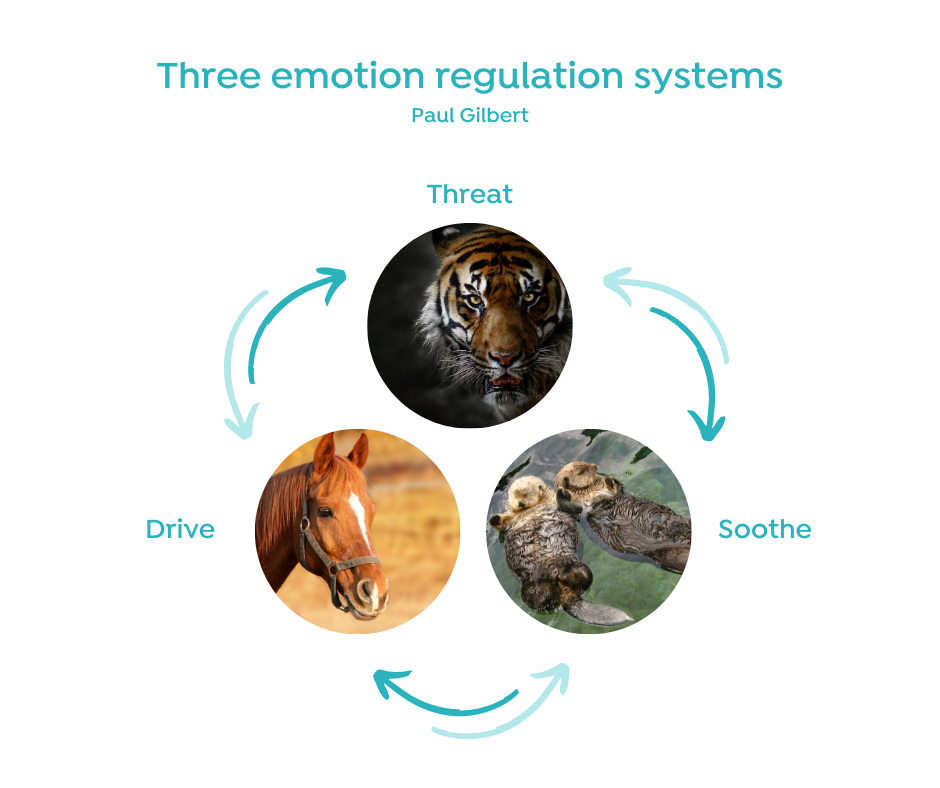
You’ll probably be familiar with the threat system. The other two lesser-known systems are the drive system – which focuses on pursuing, striving, and achievement – and the very undervalued soothe system, which focuses on calming and nurturing. These three systems work together to regulate our emotions.
But there’s a catch.
Because our brains evolved to help us survive in the wild, they don’t always function so well for our modern day. In fact, they often get in the way of us living a life of ease and joy, and of having a sense of abundance. This is primarily because of the way the threat system functions (and because there are plenty of cultural norms that continually suggest we’re ‘not enough’).
Let’s have a look at the threat system. When the brain perceives something as a threat, it triggers a whole heap of neuro-physiological activity that re-organises our bodily resources and attention around keeping us safe: this is the fight, flight, freeze and appease response, all designed to prepare us to survive. It operates on a ‘better safe than sorry,’ principle, so it’s generally very quick to kick into gear.
One of the most important parts of the threat system is the amygdala. It’s shaped like a little almond and it lies in the limbic system. The primary function of the amygdalae (we actually have two) is to process information and determine if it is a threat, and if the brain needs to take action and do something.
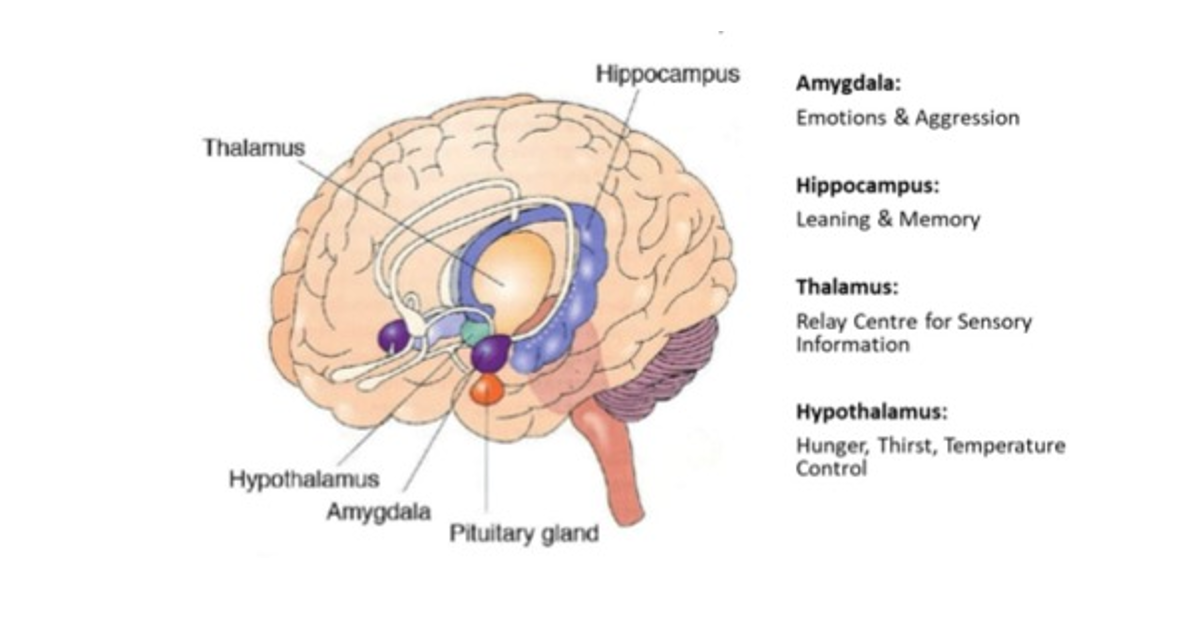
What’s wild is that 99.9% of the time, our threat system gets triggered by the THOUGHTS in our mind, not by real world events. The mind is very powerful in triggering our own fear responses.
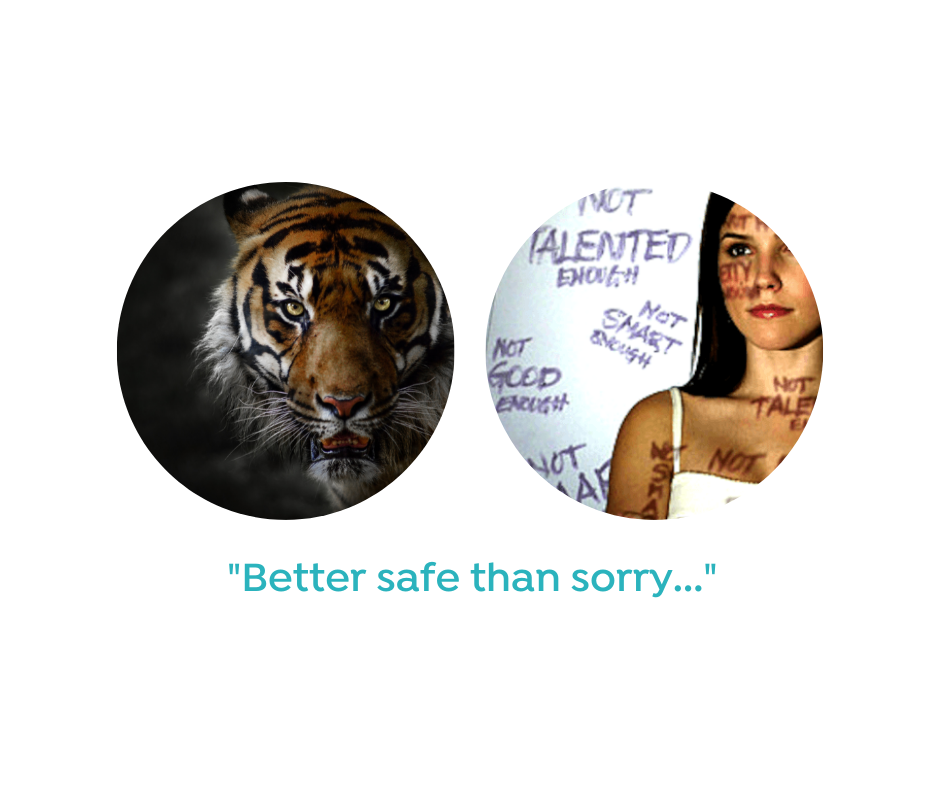
- We get overcome by fear or worry
- We get overly critical of ourselves (self-attack)
- We go into blame (other-attack)
- We hide, or avoid the task at hand
- We freeze over and disengage
Almost all the women I’ve coached in the last year are experiencing some element of this.
What can also happen is we attempt to avoid the discomfort of some of these feelings by using the drive system.
We do more, ‘be’ more, try harder, or try to control things more. When we do this, we are using the drive system to overcome our feelings of fear, anxiety and anger. The problem with this strategy is that when we eventually fail – because we can’t be 100% perfect every time – this failure to achieve triggers the threat system. So, we end up in an unhealthy loop.
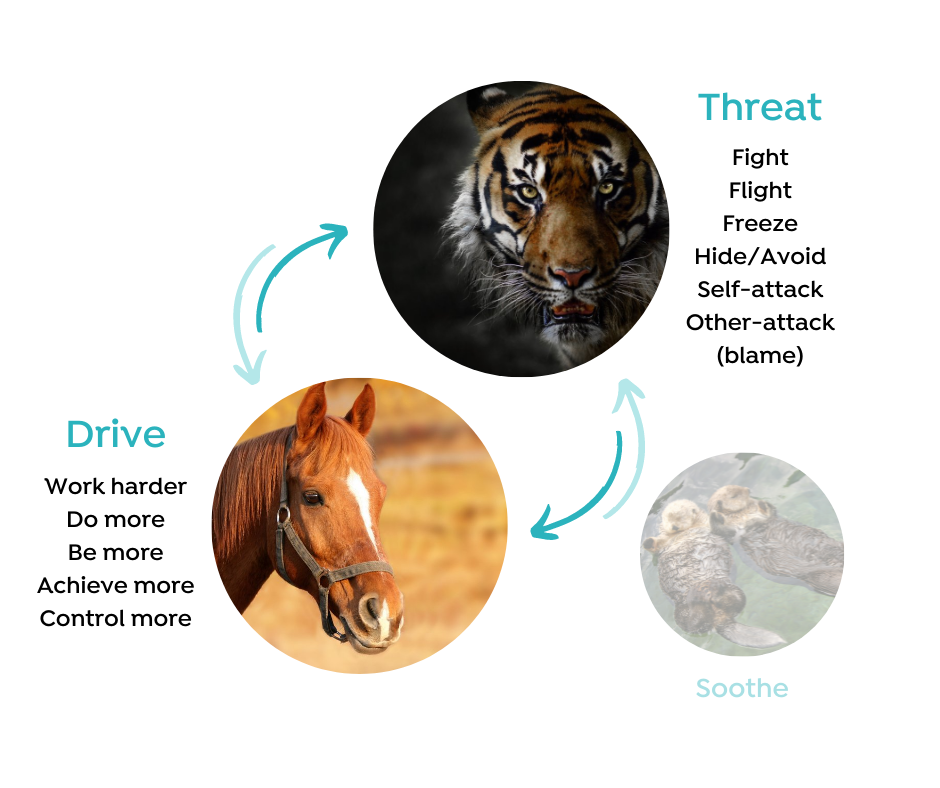
Why is this relevant to entrepreneurship? Well, there’s certain things in the entrepreneurial journey which are pretty much guaranteed to trigger our threat system: uncertainty for one. As entrepreneurs, we are building something that hasn’t existed before. We can’t say for certain that it’s going to work, but we feel driven to do it nonetheless. So, our threat system is going to go off at one point or another.

The good news is that:
- We are all in the same boat. As humans we all have this threat system in us, so we’re not alone in our experience and we can share and learn together
- It is not our fault that we have a threat system, it is how the brain evolved for survival
- We do have a choice about how to respond
- We can learn skills to help us de-activate our threat system.
There’s a couple of tools that we use with entrepreneurs to begin to help de-activate our threat system.
One great tool is called Facts and Fake News. It was created by Kate Wilson from Resources Reimagined. She shared it with us and gave us permission to use it in our work.
First, we start by listing out all the ‘stories’ that we are telling ourselves. This is the fake news, the things you’re worrying about, the story about ‘not being good enough’ (like my earlier story of getting a promotion and worrying that I wasn’t enough for the role). We just list them out here, unedited. When that’s done, we take a moment to read through all the things we’ve written, and we notice what’s going on in our body. You’ll probably notice that you feel some anxiety, maybe some shame, fear, or anger. These are all very normal. They’re signs your threat system is being activated by the story you’re telling yourself.
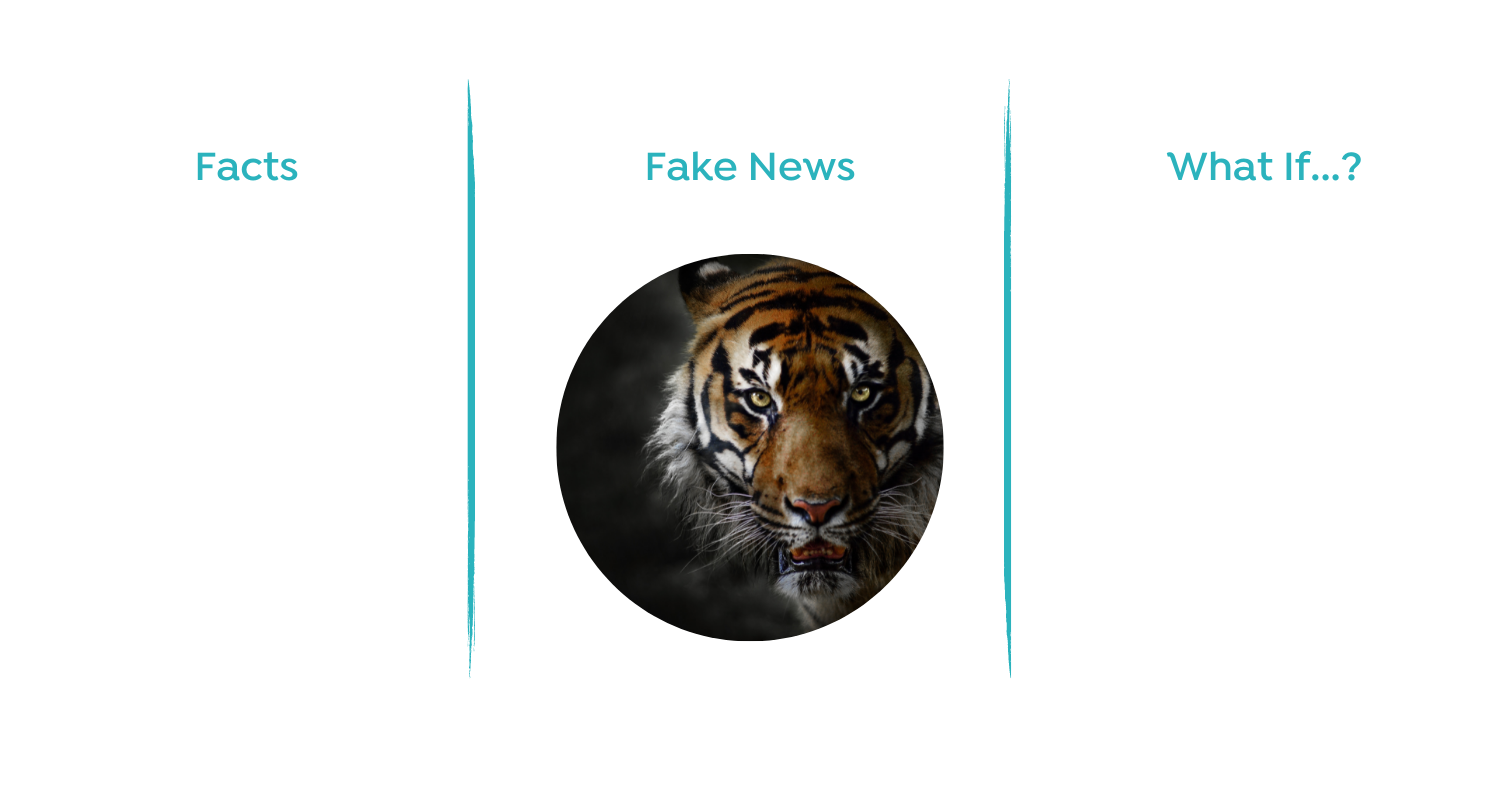
Then we list out all the facts about the situation at hand. These are things that we know to be true. Most of the time these facts directly counter what we listed under the fake news column. Once we’re done, we look at the Facts and the Fake News and we compare the two different stories that each one tells.
Usually, at this point, the entrepreneurs I work with are laughing at themselves and wondering how they could have believed the fake news.
Finally, we list out what could go right. 75% of our thoughts are negative, which means we focus most of our thinking on what could go wrong. In the last column we answer the question, what if…? And we fill it in with all the things that could go right. It’s best to be a bit outlandish here. What if my new product completely sold out on the first night? What if we won that new contract? These positive what-ifs don’t have to be true (the negative what-ifs are not true either!). The purpose is to balance out our thinking.
In summary:
- Our brains are hard-wired for survival (think: ‘Survival of the fittest’)
- Our brains are the product of thousands of years of evolution (our ancestors had good threat systems which ensured they bred and passed on their genetic material – to us!)
- When triggered, our threat systems are concerned with only one thing: SURVIVAL
- We can inadvertently trigger threat with our own minds – in the absence of any real danger!
- Most (99.99999%) of the time, threats get triggered by our minds, not our 5 senses (this includes when we appraise what is happening with our 5 Senses as ‘threatening’).
- This is not our fault – it’s just how our brains work!
- The trick is to notice it is happening
- If we want, we can choose to soothe our threat systems using a variety of skills that work with the body and the mind
- Give the Facts and Fake News exercise a try and see how you go!